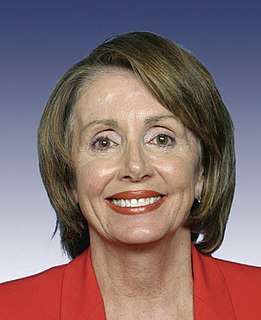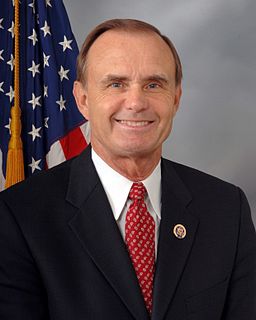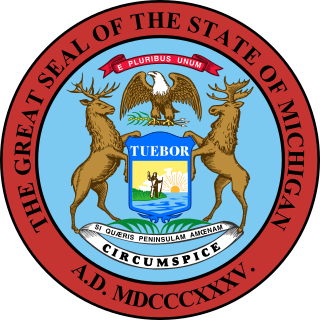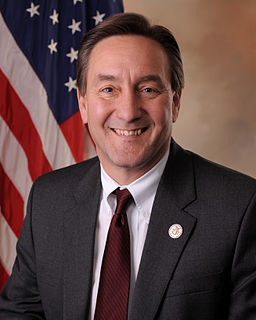
The 2006 United States House of Representatives elections were held on November 7, 2006, to elect members to the United States House of Representatives. It took place in the middle of President George W. Bush's second term in office. All 435 seats of the House were up for election. Those elected served in the 110th United States Congress from January 3, 2007, until January 3, 2009. The incumbent majority party, the Republicans, had won majorities in the House consecutively since 1994, and were defeated by the Democrats who won a majority in the chamber, ending 12 years in opposition.

Brian Phillip Bilbray is an American politician who served as a U.S. Representative for California's 50th congressional district, serving from 2006 to 2012, and previously for the 49th district from 1995 to 2001. He is a member of the Republican Party. Bilbray was Chairman of the House Immigration Reform Caucus and a member of the influential House Energy and Commerce Committee. His subcommittee assignments on the Energy and Commerce Committee were as follows: Oversight and Investigations, Communication and Technology, and Energy and Power.

A special election was held on November 7, 2006 in the New Jersey's 13th congressional district to choose a new member of the United States House of Representatives to replace Bob Menendez, who was appointed to the United States Senate. It is considered a safe Democratic seat by CQPolitics.com. Democrat Albio Sires ran for the Congressional seat for both the election for a full two-year term and for the special election to complete the final two months of Menendez's term. Sires defeated Republican John Guarini — a salesman and second cousin of former New Jersey Democratic Rep. Frank J. Guarini (1979–93). Vas did not seek the unexpired term seat. Sires margin of victory was 78% to 19%.
The Virginia 2nd congressional district election, 2006 was an election for the United States House of Representatives, held on November 7, 2006. Freshman Republican Thelma Drake narrowly defeated her Democratic opponent Phillip Kellam.

The 2006 congressional elections in Arizona were elections for Arizona's delegation to the United States House of Representatives, which occurred along with congressional elections nationwide on November 7, 2006. Arizona has eight seats, as apportioned during the 2000 United States Census. Prior to the election, Republicans held six of the eight seats and Democrats held two. In the 8th district, Republican Congressman Jim Kolbe retired, leaving an open seat. Following the elections, Democrats gained two seats at the expense of the Republicans, who lost two.

NOTE: This district's boundaries were changed in 2016. This map is not presently accurate.

The Arizona 8th congressional district election, 2006 was an election for the United States House of Representatives for the open seat of incumbent Jim Kolbe (R), who was not running for re-election. The primary was held on September 12, 2006, and the two major party winners were Republican Randy Graf, a former state Representative who challenged Kolbe for the GOP nomination in 2004, and former State Senator Gabrielle Giffords. Libertarian Dave Nolan, who was uncontested in the primary, was also in the November 7, 2006 general election. Graf was considered too conservative for the district: Kolbe withheld his endorsement, and towards the end of the election the National GOP pulled their support. By election time, most non-partisan analyses considered this race the most likely district to switch hands, which it did, as Giffords won a decisive victory, 54% to 42%.

The 2006 California 11th congressional district election was an election for the United States House of Representatives in California's 11th congressional district. The two major party candidates were longtime Republican incumbent Richard Pombo and Democratic challenger Jerry McNerney. Both faced serious challenges in their respective primaries, on June 6, 2006.

The 2006 Nevada 2nd Congressional District Election was held on November 7 to elect a representative from the Nevada's 2nd congressional district, which covers all of Nevada outside Clark County, and some parts of Clark County. Republican Party candidate Dean Heller won the election. It was an open seat because the incumbent, Republican Jim Gibbons, made a successful run for governor.

The Ohio 13th congressional district election, 2006 was an election for the United States House of Representatives. It was an open seat because Democratic incumbent Sherrod Brown ran for the U.S. Senate. The primaries were on May 2, 2006, and were won by Democrat Betty Sutton, a former State Senator, and Republican Craig L. Foltin, the mayor of Lorain, Ohio. The general election was held on November 7, 2006, general election and was won by Betty Sutton.

The Nevada congressional elections of 2006 took place on November 7, 2006 when each of the state's three congressional districts elected a representative to the United States House of Representatives. Although President George W. Bush captured the state in both the 2000 and 2004 elections, he did so with a very slim margin. Nevada was considered a battleground state due to the close victory margins.

The 2008 elections for the Texas delegation of the United States House of Representatives was held on November 4, 2008. 31 of 32 congressional seats that make up the state's delegation were contested. In Texas's 14th congressional district no one challenged incumbent Ron Paul. Since Representatives are elected for two-year terms, those elected will serve in the 111th United States Congress from January 4, 2009 until January 3, 2011.

The 2008 congressional elections in New York were held on November 4, 2008 to determine representation in the state of New York in the United States House of Representatives. New York has 29 seats in the House, apportioned according to the 2000 United States Census. Representatives are elected for two-year terms; those elected will serve in the 111th Congress from January 4, 2009 until January 3, 2011. The election coincided with the 2008 U.S. presidential election in which Democrat Barack Obama defeated Republican John McCain by a wide margin.

The 2008 congressional elections in Arizona were held on November 4, 2008, to determine who would represent the state of Arizona in the United States House of Representatives, coinciding with the presidential election. Representatives are elected for two-year terms; those elected would serve in the 111th Congress from January 4, 2009, until January 3, 2011.

On November 7, 2006, New York, along with the rest of the country held elections for the United States House of Representatives. Democrats picked up 3 House seats, the 19th, the 20th, and the 24th.

The 2008 congressional elections in Michigan were held on November 4, 2008 to determine who would represent the state of Michigan in the United States House of Representatives. Michigan had fifteen seats in the House, apportioned according to the 2000 United States Census. Representatives are elected for two-year terms; those elected will serve in the 111th Congress from January 4, 2009 until January 3, 2011. The election coincided with the 2008 U.S. presidential election.

The 2006 United States House elections in Pennsylvania was an election for Pennsylvania's delegation to the United States House of Representatives, which occurred as part of the general election of the House of Representatives on November 7, 2006.
The 2008 congressional elections in Virginia were held on November 4, 2008 to determine who would represent the Commonwealth of Virginia in the United States House of Representatives, coinciding with the presidential and senatorial elections. Representatives are elected for two-year terms; those elected will serve in the 111th Congress from January 3, 2009 until January 3, 2011.

The 2010 House election in North Dakota took place on November 2, 2010 to elect the state's At-large Representative to the United States House of Representatives. Representatives are elected for two-year terms; this election was for the 112th Congress from January 3, 2011 until January 3, 2013. North Dakota has one seat in the House, apportioned according to the 2000 United States Census.

















